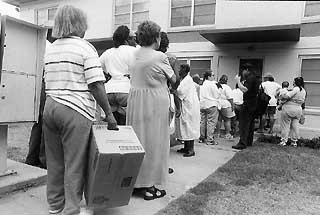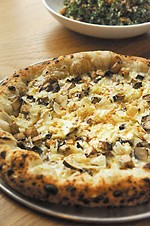Carrying the Burden
Bridging the Food-Security Gap in the Texas Capital
By Virginia B. Wood, Fri., April 28, 2000

It's the third Wednesday morning of the month. Rosewood Apartments resident Heather Moore is babysitting her niece and nephew Ciara and DeMontre Wilkerson when it's time to get in line for the monthly produce drop. Earlier that morning, a truck from the Capital Area Food Bank dropped off hundreds of pounds of donated, perishable foods at the East Austin housing project. Now residents' council president Genaro Hernandez, his wife Maria de la Luz, and a staff of volunteers are filling boxes with groceries for the residents. When Heather and her small charges emerge from the client services office, her box is loaded with a small bag of potatoes, a couple dozen eggs, tubes of biscuits, a package of prepared brownies, a bag of Dole pre-cut salad, and some cans of baby formula. Ciara totes her own package of eggs, and DeMontre wrestles with a half-gallon of Minute Maid juice almost as big as he is. Once they've carried the groceries back to their apartment, Heather and the little kids wander back to the drop site to visit with other residents while the life-sustaining, regular food distribution continues. The crowd is mostly single moms or dads with small children in tow and single elderly people like Helen Gibbs. She's a grandmother living on Social Security disability who stops by for groceries on her way home from a computer-skills class. Mrs. Gibbs will share the food in her box with her recently widowed son and a four-year-old grandson. After the residents patiently work their way through the distribution line, many folks rummage through a large box outside that's filled with donated day-old bread from Central Market. Ciara Wilkerson and a neighbor boy eventually entertain themselves staging a mock duel with long, skinny baguettes. Food bank volunteers come and go, taking pick-up loads of food to smaller sites such as the Booker T. Washington projects and a nearby complex that houses 100 senior citizens. After about an hour and a half, all the food for this week's distribution has been dispersed, and roughly 500 people have received groceries to help sustain them through the rest of the month. This whole scene takes place roughly 10 miles due east of the official residence of Texas governor and Republican presidential candidate George W. Bush, who last year expressed doubts about the existence of hunger in Texas.
During Gov. Bush's campaign for his party's presidential nomination last fall, reporters asked the candidate to comment on a federal government report asserting that many Texans, including large numbers of children, were going to bed hungry. "I saw the report that children in Texas are going hungry. Where?" he demanded, going on to say, "You'd think the governor would have heard if there are pockets of hunger in Texas." Indeed, you would, especially if one of those pockets is just a few miles from his front door. According to a U.S. Department of Agriculture study titled "Measuring Food Security in the U.S.," the Lone Star state ranks second in the nation in the numbers of people suffering from hunger: More than two million Texas residents have trouble consistently affording food (described as "food insecurity"), with almost half of that number suffering from outright hunger.

Governor Bush's statements about hunger drew the attention of Democratic state representatives, social-service agencies, anti-hunger and anti-poverty activists, as well as local, state, and national media. (In fact, a freelancer on assignment from George magazine visited the Rosewood produce drop the same day I did.) Bush's denial of the hunger problem in Texas made me very curious about hunger conditions here in the thriving Sunbelt high-tech boomtown were he currently lives. To his credit, Bush also said, "I want to know the facts. I would like for the Department of Agriculture to show us who, where they are, and we'll respond."
Hunger: What Is It, Exactly?
Because hunger is a difficult thing to quantify, social-service agencies have developed the "food security" model to denote something more than the actual physical sensation of being hungry. Food security, as defined by the Food Security Institute (FSI) at Tufts University, refers to the "assured access to enough food at all times for an active and healthy life, and minimally includes the availability of nutritionally adequate and safe foods and a guaranteed ability to acquire acceptable foods in socially acceptable ways." Food insecurity occurs whenever the availability of nutritionally adequate and safe foods or the ability to acquire them in acceptable ways (without, say, stealing or dumpster diving) is limited or uncertain. In our interviews with food-bank directors and soup-kitchen service providers alike, the term "food insecurity" was frequently used to describe the situation of Austin's homeless and working poor.
It's hard to believe there could be people without access to safe, nutritious food in one of the fastest-growing high-tech meccas in the country. Prosperity is all around us: The real estate business is booming, and it's not possible for the construction trades to build houses and apartments fast enough to meet demands; new upscale restaurants and shopping centers blossom all over the Central Texas area while unemployment is at an all-time low, 2.6%. Austin's "Smart Growth" seems to be an increasingly popular topic. When the media covers social and civic concerns, even those are prosperity-related. The topic of light rail transit keeps popping up, and we want to reroute truck traffic around the city and improve roads. Ecological preservation is still very much a front-burner issue in these boom times, and we're finding it necessary and important to invest in upgrading many of our cultural amenities, such as the convention center, the art museum, and the performing arts center.
No one denies that all these concerns are valid and deserve our attention. It's just that the higher rents that have arrived hand-in-hand with all this prosperity are about the only economic hardship that gets regular media coverage in the Austin metropolitan area. Since high housing costs are something we can all relate to, let's use that as a window to the other side of the attractive social environment and prosperity-oriented picture of Austin. Based on information from a 1999 Travis County Health & Human Services Basic Needs Assessment Report, close to 100,000 area residents live below the poverty line of $16,700 per year for a family of four, 43% of all Travis County public-school students qualify as economically disadvantaged, and 200,000 more Travis County residents are classified as "the working poor." We have a poverty rate of 12% despite that attractive 2.6% unemployment figure. Assuming Austin's poor have seen the same increase in housing costs as the rest of the population, as well as seen the cost of living rise 17% in the past decade with no increase in federal funding for public assistance, we have to ask ourselves, how are they feeding their families?

One thing is for sure: They aren't getting as much help from the state or federal governments as others in their situation did in the past. The social-service "safety net" of programs begun during the Kennedy and Johnson administrations, whatever their faults, have been gutted in the past 20 years. The free marketeers of the Reagan/Bush era preached economics, self-sufficiency, and a stronger work ethic to combat poverty, and while overall incomes did increase during those administrations, poor families actually saw their incomes decline with rising inflation. Military spending rose with corresponding deep cuts in welfare spending. Welfare-reform legislation by the spiteful Gingrich Congress finally managed to turn the War on Poverty into something that looks remarkably like a war against America's poor. Passage of the Personal Work Opportunity and Responsibility Act of 1996 (PWORA) has severely limited access to food stamps despite their proven effectiveness in combating hunger in the U.S. The new "welfare to work" model limits assistance and forces former welfare recipients into mostly low-paying jobs, in many cases increasing the need for charity. New York Times writer Andrew Revkin describes this as the "ritual of poverty," where former welfare moms with no employment options other than low-wage jobs make too much money to qualify for the newer, more stringent food-stamp requirements but don't make nearly enough money to adequately feed their families.
Every capital area social-service provider we contacted referred to the twin issues of decreased federal welfare/food-stamp spending and increased local cost of living as the main factors contributing to Austin's food-security gap. Requests for assistance in meeting basic needs (food, clothing, shelter) for families of the working poor, the disabled, and the low-income elderly are at an all-time high in Austin, surpassing the capabilities of local government agencies, social services, and religious and charitable institutions to respond to those requests.
Cautious Optimism
The afternoon I met with Capital Area Food Bank (CAFB) director Judy Carter and deputy director Dan Pruett at one of the three Kid's Cafe locations funded by the food bank, they were in very high spirits. An Austin radio station had auctioned front-row seats to the upcoming Bruce Springsteen concert donated by the artist. The lucky winner had just dropped off a check for more than $5,000 made out to the food bank, one of Springsteen's favorite charities. Carter and Pruett always have an eye on fundraising, looking for support from grocery-store chains, private industry, regular food drives, and individual donors. Every $5,000 windfall brightens their day, especially when they are working so hard to increase the number of local Kid's Cafe dinner sites within the next year.
The three Austin Kid's Cafes provide a hot dinner two evenings a week to children who are participating in after-school enrichment programs at three East Austin locations -- the Boys & Girls Club at the Alternative Learning Center, the River City Youth Foundation in the Dove Springs area, and the Del Valle Tutorial Program at Hill Country Elementary. In order to qualify as a Kid's Cafe site, the agency must already have enrichment programs in place, such as tutoring, mentoring, and sports, to which meals can be added as an enhancement two nights a week. The food bank provides all the funding for the Cafes, including salaries for the cafeteria workers who prepare the food, cooking utensils, groceries, paper goods -- whatever it takes. Funding comes from private grants and donations. A $17,000 grant from the Dell Foundation funds the Kid's Cafe at the Boys & Girls Club site this year.

Tony Kennedy is the site director at the East Austin Boys & Girls Club. At 5pm, he blows his whistle, and about 40 kids drop what they're doing and noisily assemble for the short walk from the gymnasium to the cafeteria. They range in age from six to about 14 and are busy and boisterous, regular kids. They file through the cafeteria line and emerge with trays loaded with a steaming hot meal: chicken in barbecue sauce, Spanish rice, green beans, cartons of milk, and a choice of bright green Jell-O or a confetti-laced slice of cake topped with a jellybean. When asked about what their favorite meals are at the regular Cafe, there are mixed responses: "Hot Pockets," says one young man at our table. "No, pizza, pizza's the best," another says. Or "I like bis-ketti" ("You mean spaghetti, stupid!" his companions laugh). They're busy enjoying dinner and may go back for seconds if they're still hungry after cleaning their plates. The kids don't pay us much mind, although Chronicle photographer John Anderson's camera fascinates a few.
According to Carter and Pruett, any children who participate in the after-school programs where Kid's Cafes are offered are welcome to come for dinner. Their elder siblings can come, too, if they want, and parents are allowed to volunteer if they'd like to come and eat. "We want to do anything we can to support the family unit," Carter explains. Judy Carter also tells me that many, if not all, the children who dine at Kid's Cafes also participate in the free- or reduced-breakfast and lunch programs at the AISD schools they attend. This prompts a question -- where will they eat those important meals in the summertime? To which she responds, "The city Parks & Recreation Department has a lunch program at several sites around the city that try to pick up the slack [see sidebar], and we're planning to increase the Kid's Cafe nights from two times a week to three during the summer." Otherwise, it's anybody's guess how the kids' families will replace the meals regularly provided at school and the Cafe.
CAFB deputy director Dan Pruett is cautiously optimistic that the food bank can increase the number of Kid's Cafe sites from three to eight by the fall of 2000. This means finding more businesses, foundations, and individuals who will put up the actual cash and rounding up more groceries from generous donors such as Borden's, which already provides all the milk for the Cafes. The program now serves several hundred meals a week to hungry kids, creates increased employment hours for low-income cafeteria workers, and is an important food-security tool in the neighborhoods where it happens. Before the children of the Boys & Girls Club leave the cafeteria, leader Tony Kennedy poses a question: "How do we let the cooks know what we think about this great chicken dinner?," to which the kids respond with a rousing cheer of "Thank you, Mrs. Caldwell!"

Kid's Cafes are only one of the many programs the CAFB uses to bridge the local food-security gap. Every Wednesday, there's a regular produce drop at a predetermined site. Describing what occurs simply as a "produce drop," however, doesn't really do justice to what happens. A truck from the food bank arrives at the East Austin or Montopolis Neighborhood Centers, the Rosewood Apartments, or the Rosewood-Zaragosa Community centers and deposits hundreds of pounds of perishable foods to be distributed among residents. On any given day, they'll have eggs from HEB, produce from Texas Health Distributors, milk from Borden's, day-old bread from grocery store in-house bakeries, juices or prepackaged salads from manufacturers such as Minute Maid or Dole, or farm-fresh produce from the Texas Department of Corrections Hobby unit farm near Waco. Residents line up for boxes of groceries to augment their monthly food supply. There's no picking or choosing. It's an amazing process to watch, and it could be expanded with more food donations plus the allocation of important CAFB resources such as trucks, staff, and volunteers.
Caritas' Safety Net
Caritas, from the Latin word meaning love, was founded in 1964 by Monsignor Richard E. McCabe of the Diocese of Austin to "provide a safety net for Austin's working poor, homeless and legal refugees while encouraging them to become economically self-sufficient." The interdenominational, interfaith organization was incorporated as a private nonprofit in 1997. Caritas offers three worthwhile, long-term comprehensive programs to assist in meeting the basic needs of their homeless and refugee clientele. An increasing number of individuals and families are seeking assistance from Caritas for relief from their food insecurity problems. This past year, the downtown charitable mainstay moved into larger, more accessible facilities at the corner of Seventh and Neches. That's where they gave a tour of the food pantry and bustling soup kitchen.
This being April, the supplies on the shelves at the Caritas Food Pantry are beginning to look a little sparse. The food drive sponsored every year in November by Amelia Bullock Realtors generates more than 100,000 pounds of nonperishable canned and packaged foods for the pantry every year; that usually lasts about six months. The three paid staff members and a group of community volunteers also contact local grocery stores and bakeries to make arrangements to pick up perishable foods such as day-old breads. Long before the stock donated by the food drive disappears, the Caritas development staff will be looking for the funds and donations to replace the supplies and keep the pantry open until the following November. Caritas clients present food vouchers at the pantry window and in return receive bags of food to last for two to three days. This pantry is one of the largest and busiest of the nearly 50 food pantries in the Austin metro area (see sidebar). Caritas provides groceries, baby-care items, and personal-hygiene products to approximately 16 families every day, or an estimated 3,874 households per year.
One of those clients was a 33-year-old single mom named Melissa (not her real name) who found herself trying to start over in Austin with a nine-year-old daughter, little money, and no friends or family. Melissa fled her financially secure but abusive marriage and relocated to Austin thinking she could stay with a relative. She arrived in Austin with her daughter, her car, and roughly $1,000 only to find that the relative had died. After a few weeks of staying in hotels and then camping out, Melissa arrived at Caritas, broke and without any idea of where to get her next meal or night's lodging. Within a month, Melissa had her daughter enrolled in school, a full-time job in retail, and a place to live. Caritas was able to assist Melissa and her daughter with move-in rent, gas for the car, food vouchers, clothing, prescriptions, and a few household items for the apartment plus connections to other community resources. She was able to use food-pantry vouchers for groceries to feed herself and her daughter while she waited for her first paychecks.

While struggling families and low-income elderly make up the bulk of the Caritas food pantry clients, the Loaves and Fishes Soup Kitchen serves lunch to 200-300 mostly homeless folks every day. There's no qualifying requirement -- everyone who shows up to eat gets fed as long as they're not violent or under the influence of alcohol/drugs. On the Wednesday we were there, a security guard stands at the entrance handing out voucher tickets, and the long line progresses to the service window in an orderly fashion. In the sparkling new commercial kitchen, the operation is in the able hands of retired restaurateur Tib Scallon (he owned Moreburgers on MLK and Guadalupe in the Sixties and Seventies) and a daily changing group of cheerful, very committed volunteers. One of the women serves soup out of a big, new, tilting kettle while others load trays with sandwiches and dessert and someone else fills orders for milk. The line moves pretty quickly, with customers stopping to fill large glasses with pre-sweetened tea. (Scallon points out that they serve lots of sweets, donated prepackaged items such as cakes, coffee cakes, cookies, candies, brownies, and gallons of sweet tea because so many of their customers come off alcohol and drug addictions with sweet cravings.) Diners find a place at the rows of tables, eat their meal and move along, making space for the crowd that's coming behind them.
The food Tib Scallon and his small staff and large volunteer teams prepare and serve every day comes from a variety of sources. "I get lots of leftover prepared food from Jester Center," he explained, "things like beef or chicken fajitas, vegetables, and stuff that I can turn into soup every day." He depends on brokers such as Triad for sandwich meats, Randalls stores or Upper Crust Bakery for perishables, bread, and sweets, and purchases staples like rice and beans at reduced prices from the food bank. "If I need to fill in here and there, I go to Sam's and get stuff, although that's usually just paper goods," he says. Tib reports that since moving to their new facility several months ago, he's seen an increase in daily service from 200-225 meals a day to 250-300 meals. The demand for meals isn't dropping off during the first couple weeks of every month as it did in the past. Most of the customers are single, homeless men with a smaller number of women in the crowd. "They see more families with kids across the street at the Sally [Salvation Army], but we tend to get some kids during holidays like spring break and the summer," Scallon tells me. It's obvious that he and his devoted crew do a good job of using the donated "loaves and fishes" to feed their hungry clientele.
Sustainable Self-Sufficiency
Of all the programs we visited, the six-year-old Sustainable Food Center (SFC) has less to do with providing emergency food assistance to hungry Austinites and more to do with creating a self-sufficiency model that really works. The mission of the SFC is to strengthen personal and community food security, which they define as "the ability to access and prepare food that is safe, affordable and nutritious and grown in a manner that is sustainable and available year-round without reliance on emergency sources." That's a very large goal for a struggling, under-funded community nonprofit, but the staff and volunteers of the SFC are determined to meet that goal and stand a good chance of doing so, considering the quality of their programs.
Outgoing executive director Anna Maria Signorelli met with me to explain the successful SFC programs. "I know it's an old cliché, about giving a hungry man a fish only feeds him for one day, but teaching him to fish feeds him forever," she explained with a shrug, "but that axiom is what our programs are based on." That's why the nonprofit is the "sustainable" food center. The SFC sponsors the Cocina Alegre (Happy Kitchen) Food School, a series of summer farmers markets, and the Jardin Alegre (Happy Garden) Community and Youth Gardens. The Cocina Alegre Food School, staffed by a professional health educator and a professional cook, teaches up to 25 six-week cooking courses every year. Participants learn how to budget for, shop for, and prepare economical meals for their households using fresh, nutritious ingredients (see sidebar). After each class, students are given a bag of groceries containing the ingredients of that class' recipes so they can go home and prepare them for their families. "We're so lucky that local grocery-store chains are interested in supporting this program," Signorelli told me.

While there is no need for verification to qualify for Cocina Alegre classes, most of the agencies that request the classes serve Austin's low-income populations: CIS, CEDEN Family Resource Center, El Buen Samaritano, city neighborhood and recreation centers, Seton Clinics East and South, parent/teacher organizations, diabetes support groups and even churches. The Cocina Alegre is so successful that the SFC is now developing a model package that contains the curriculum, a cookbook, and an education model for training peer counselors. This package should be ready for sale to agencies around the country sometime in 2001. In the meantime, the Cocina just graduated a bilingual class at El Buen Samaritano taught by peer counselors Carolina Lopez and Sonya Camacho. By training peer counselors to teach the cooking classes, the SFC increases their outreach potential with more teachers while providing self-esteem, job skills, and an income to members of their client base. Everybody wins.
Another winning program developed by the SFC is their collection of community gardens around the East Austin area. Beginning with their Jardin Alegre Community Garden on East Second near Comal and spreading to other locations at the Montopolis Community Center, Martin Junior High, Allison Elementary, SafePlace, and the Santa Rita housing projects, the SFC is growing fruits, vegetables, and flowers along with community volunteers and young gardeners. Felipe Camacho runs the gardening program aided by knowledgeable senior citizen volunteers such as Mrs. Rita Miles and hardworking kids like Apolonia "Apple" Tovar. I caught up with them late one afternoon while Apple was patiently watering tomato plants in raised beds behind the Montopolis Community Center and lifelong gardener Rita Miles raked another bed preparing it for a new crop. According to Camacho, they'd recently harvested their big supply of beets and kohlrabi for sale to the Bitter End bistro and were trying to decide what to do with an abundance of Brussels sprout greens. "I've enjoyed gardening all my life," said Mrs. Miles. " I've got to have my black-eyed peas, okra, and green beans, things like that. It's lots of fun teaching these young folks to garden."
Young participants in the SFC gardening program are taught organic methods using donated seeds and bedding plants. The kids and seniors who tend the gardens get some produce to take home, and the rest is sold to local restaurants or in the five SFC farmer's markets. Their goals for the coming year call for increasing their urban orchards (with fruit and nut trees provided by Treefolks) as well as increasing honey production from hives set near some of the garden plots. Garden plots are available at the Jardin Alegre at Second and Comal for low-income families and seniors with training and assistance available. The program not only provides fresh, seasonal organic produce for children and their families, it also creates an important connection to the earth and the neighborhood and a genuine sense of accomplishment on the part of the young gardeners. "Even the kids who have already completed their time in the gardening program are very respectful of what we're doing. We've had no vandalism in these gardens and no tagging on our signs or murals at any of the locations," Camacho points out with pride.
For an agency with such successful programs, the Sustainable Food Center is still a small nonprofit that struggles for funding month-to-month. In order to stabilize their finances somewhat, they've begun charging the agencies who request Cocina Alegre programs, and they've instituted a membership-fund drive to increase local donations. They've recently invited high-profile Austin restaurateur Mark Katz to join their board in the hopes that he'll make the name of the Sustainable Food Center as recognizable as his own. The value of SFC programs has come to the attention of the national hunger-relief organization Share Our Strength, which is a regular recipient of charitable donations raised by the Austin SOS dinner gala (see sidebar).
These agencies and many others staffed by committed social workers and caring volunteers strive daily to help low-income Austinites bridge the food-security gap. Everyone interviewed would gladly welcome a visit from governor and presidential candidate Bush to educate him and his staff about the issue of hunger in Austin and the rest of the state. When we asked for their suggestions about solutions to the food-security problem, local activists wanted to remind Austinites that the overall prosperity we experience doesn't extend to everyone, and more regular charitable donations are necessary. And they uniformly called for the reinstatement of individuals and legal aliens to food-stamp eligibility and increased funding for the food-stamp program, which has been proven successful in fighting hunger in this country.
In my conversation with Share Our Strength founder Bill Shore, he echoed knowledgeable locals when I asked him what advice he'd like to give both presidential candidates in this election year. "I'd encourage them to take full advantage of our current prosperity to resolve the problem of hunger. If there was ever a time when we can afford better education and training for low-income workers, clearly this is it," Shore told me. "I'd like to see them make a commitment to overturn some of the welfare reforms that have had a devastating effect on food security and fully extend the food-stamp program to people who need it." After visiting the various Austin agencies and programs who do such yeoman service in the face of limited funds and ever-increasing demands, here's what I'd like to see: a canned-food donation included in the cover charge at clubs, theatres, and movie houses; local high-tech companies establishing stock portfolios to fund hunger-relief programs; and Gov. Bush looking hungry Austinites in the eye while he fills their grocery boxes at a CAFB produce drop. ![]()








